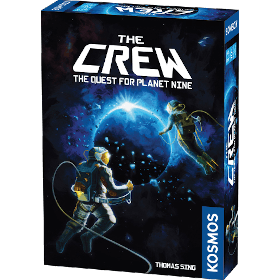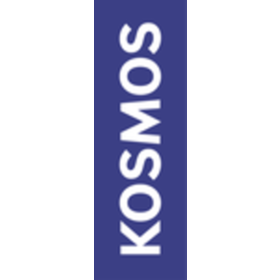스페이스 크루
 협동 트릭테이킹 게임인 '스페이스 크루: 9번째 행성을 찾아서'에서 플레이어는 불확실성이 가득한 우주로 여행을 떠난 우주비행사가 됩니다.
협동 트릭테이킹 게임인 '스페이스 크루: 9번째 행성을 찾아서'에서 플레이어는 불확실성이 가득한 우주로 여행을 떠난 우주비행사가 됩니다.
미지의 행성에 대한 소문은 어떨까요? 우주에서의 파란만장한 여정은 50개의 흥미로운 임무들을 통해 이루어집니다.
그러나 이 게임에서 승리하려면 공통 과제나 개인별 과제를 모두 완수해야 합니다. 제각각 다른 난제를 달성하기 위해서는 팀 내 소통이 필수적이지만, 우주에서는 당초에 생각했던 것보다 일이 힘들게 흘러가겠죠.
플레이어 수: 2 - 5
게임 시간: 33 mn
복잡성: 2 / 5
스페이스 크루 및 다른 게임 977개를 온라인으로 즐겨보세요.
다운로드가 필요없으며, 웹 브라우저에서 바로 플레이할 수 있습니다.
친구들과 그리고 전세계의 수많은 게이머들과.
무료.

스페이스 크루 및 다른 게임 977개를 온라인으로 즐겨보세요.
다운로드가 필요없으며, 웹 브라우저에서 바로 플레이할 수 있습니다.
친구들과 그리고 전세계의 수많은 게이머들과.
무료.

규칙 요약
Introduction
The aim of the game is to investigate the possibility of a mysterious ninth planet in our solar system by completing 50 different missions of increasing complexity by working as a team, but with very limited communication permitted.
Each mission consists of a series of tasks and may have additional victory conditions and/or complications. For example, frequently the tasks must be completed in a certain order.
The game mechanic is similar to Whist or other trick-taking card games, except that the game is played cooperatively as a group. Mission tasks are completed by specific players winning tricks containing specific cards.
Initial Setup
The deck consists of 36 Colour Cards (1 to 9 value in four coloured suits) plus 4 black Rocket Cards (1 to 4).
These 40 cards are shuffled and all cards are dealt out equally (although in a three player game, one player will have more cards than the others).
The player who has been dealt the 4 Rocket must act as the Commander for that mission. They receive the Commander Token to indicate this and must go first.
Each player also receives a grey Reminder Card (with a picture of a planet) and a double-sided Communication Token, which are both placed in front of them on the table. The Communication Token is initially placed green side up.
A double-sided Distress Token is placed face down in the centre of the table (on Board Game Arena, this appears in the green mission briefing area)
A deck of 36 Task Cards is shuffled and kept as a concealed pile. There are also 10 purple Task Tokens. Each attempt at a mission will therefore have a random set of task cards, and may (or may not) require a specific set of task tokens. On Board Game Arena, this is all handled behind the scenes.
Missions
There are 50 unique missions. Each mission describes the conditions under which it is played.
A number of tasks as specified by the mission are placed in front of the players. Unless otherwise specified by individual mission requirements, these are divided between the players. The Commander chooses first and then choice of task proceeds clockwise around the table until all tasks have been assigned.
Certain missions may have additional conditions. These are explained in the mission text.
Where task tokens are required, some or all of the tasks must be completed in a particular order, e.g. a task might have to be completed "first", or "before" or "after" another.
A player completes a task by winning a trick that contains the specific card that is indicated on the task card, so long as they also fulfill any additional conditions per the task tokens.
Trick Taking
The Commander will have the lead at the start of the game. Play proceeds clockwise.
Highest card wins. A player must follow suit unless they have no cards of that suit.
The Rockets are trump cards and can only be beaten by higher value Rockets. Rockets are counted as a separate suit, and you must follow suit if a Rocket is led.
The winner of each trick takes the lead for the next trick.
As each trick is played, if one of the cards indicated by a task is won by the owner of that task and any other conditions such as task order are met, the task is complete.
If a card indicated by a task is ever won by someone other than the owner of the task, or winning the card has meant that other task / mission conditions have not been met, then the mission is instantly failed and must be replayed in order to proceed.
Communication - how to help your crew
Once per mission, you may at any time click on your Reminder Card (in some browsers anywhere on the card except directly on the green Communication Token itself) to indicate that you wish to communicate some limited information about your hand to the other players.
Once you have clicked on the token, you will not be able to communicate immediately - there will be a communication phase at the start of each trick. By clicking on the token you indicate a desire to participate in the next available phase. If this phase has been triggered, communication then proceeds in clockwise order starting from the person with the lead. Only players who had clicked on their tokens prior to that phase may participate - if you forget to click in time, then you will have to try again ahead of the next round.
If you have selected the communication token during a trick but then change your mind when it gets to the communication phase, you may refrain from communicating and try again at the start of a future round (or not at all).
When communicating, you may choose a card in your hand to show to the other players. This card is then placed on the table under the Communication Token, which is then flipped to the red side to indicate that it has been used during this mission. You also pick up the grey Reminder Card which is placed in your hand to remind you and the other players that you still have a communicated card on the table.
The chosen card must be either:
- The lowest card you hold in a particular suit (token placed at bottom of card)
- The only card you hold of a particular suit (token placed in middle of card)
- The highest card you hold of a particular suit (token placed at top of card)
So if at any given moment you had the 1, 2, 5 and 7 of a particular suit, you would only be able to communicate about the 1 (lowest) or the 7 (highest), but not the 2 or 5 as they do not meet any of the 3 communication criteria.
The communicated card then remains face up on the table until it has been played. At that time the Reminder Card is placed back on the table.
Distress Signal - what if more help is needed?
Some missions may be difficult to complete due to the random nature of both the tasks and the cards themselves.
At the beginning of the mission, after the cards and tasks have been assigned, but before any communication has been made or cards have been played, the black distress signal token in the green mission briefing area may be activated. If this is done, the token is flipped and its use is logged.
Each player may then pass one of their cards to one of their neighbours. Rocket cards cannot be passed. All cards must be passed in the same direction; the players may agree upon the direction to pass.
Additional Mission Conditions
Dead Zones
Where indicated, communication is limited even further.
The basic communication mechanics (in terms of which cards you may choose to communicate) are unchanged, but the communication token must be placed in the centre of the card.
As a result, you can no longer tell what a player is communicating about a card (only that they have it, and that it is either their lowest, highest, or only card of that suit.
Disruption
Where indicated, no communication whatsoever is allowed until the beginning of the indicated trick.
For example, if "Disruption 3" is indicated, then no communication would be possible during the first two tricks, players may however communicate before the third trick is started.
Commander's decision
Where indicated, the commander will ask each other player in turn whether they think they are capable of completing all of the tasks for this mission - they must each answer yes or no.
Once all players have responded, the commander will choose which of the players should receive the tasks.
The commander must choose one of the other players, not themselves.
Commander's distribution
Similar to the above, the commander offers one task at a time to each of the other players, who may each answer yes or no. The commander then chooses which player should receive that task.
This is then repeated for any additional tasks. The tasks must be evenly distributed - nobody may have two more tasks than anyone else.


